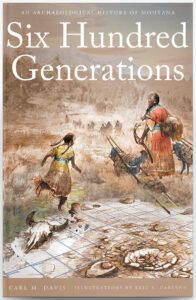
For some, American history starts when Europe reached across the Atlantic to touch the shores of the ‘New World.’ According to Carl Davis, it should be more common thought that the history of this corner of the world reaches back much further. The retired archaeologist spoke Saturday at the Historic St. Mary’s Mission in Stevensville about just that. Davis gave a presentation to an audience of a couple dozen people of what life was like prior to, and after, European migration into the Americas.
He first spoke about the tremendous diversity across the Americas, and Canada, of peoples and cultures. Davis then talked about how cyclical warming and cooling of the earth affected human migration across the globe for at least the last 25,000 years. According to Davis, at one of these points humans from Europe in a portion of the Mammoth Steppe, and in an area near modern day northeastern Russia, crossed the Bering land bridge into the Americas. After coming up to great mountains of ice pack, it is possible, according to Davis, that they then traveled south to colonize the rest of the continent, within the short order of only a few thousand years. According to Davis, this looks to have been done primarily by boat, though there may have been those who made it through several ice corridors into the American interior. Davis explained that it is safe to say that people have been on the continent for at least 15,000 years.
After his introduction, Davis spoke about many cultures, their lifestyles and importantly to him, how they all worked together in the big picture of native life across the country. He explained that they did this thorough warring, peacetimes and European settlement included. He also spoke on how archaeologists study and come to this information. “The things that archaeologists find are garbage, basically. Things that have been largely left behind.” According to him, these bits of broken and lost things, along with other sciences, help string together a greater picture of ancient and historic life.
Davis’s presentation was organized by the Historic St. Mary’s Mission group, in conjunction with Humanities Montana, which provided the presenter. Dora Bradt, Executive Director of the mission organization, explained that the group has plans for more presentations like this. The mission has already held several monthly presentations as part of their Saturday Series. This series sees one Saturday a month, usually the third weekend of the month, invite a presenter or group to give a talk of historic significance for the area. Their next event will be “Living with the Land” with Louise Fischer. This presentation is scheduled for April 22 at 11 a.m. Fischer will speak on Native American survival in harsh climates as well as spiritual and creative achievements. The event is meant to convey an understanding of the relationship natives had with the land.
The information in Davis’s presentation can be found in further detail in his published book, “600 Generations: An Archaeological History of Montana.” Davis also does work with schools and strives to connect views on history. “I love Archaeology. I just feel like we have to connect indigenous history and American history,” said Davis. “I feel there is a disconnect. Despite what some may think, native peoples were totally engaged in how our history was formed.”
Davis’s book can be found on Amazon and in local bookstores. For more information on the Historic St. Mary’s Mission, you can call (406)777-5734 or visit saintmarysmission.org.

Mike Miller says
“Carl Davis (above) speaks on the first peoples to migrate into the Americas.”
That means they’re NOT native, but came from somewhere else and immigrated.
To call one group of immigrated people native, when in fact they’re immigrants, is wrong. To say they’re the only natives, is racist.